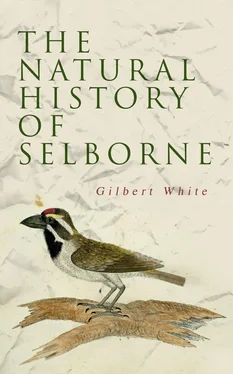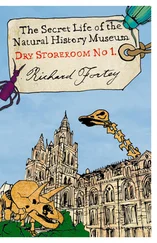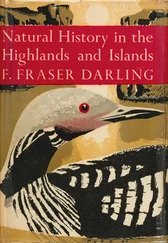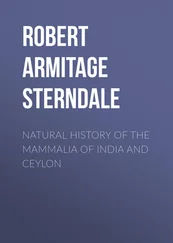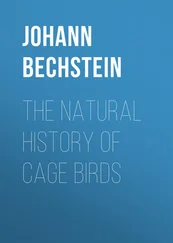Cornua Ammonis are very common about this village. As we were cutting an inclining path up the Hanger, the labourers found them frequently on that steep, just under the soil, in the chalk, and of a considerable size. In the lane above Wall-head, in the way to Emshot, they abound in the bank in a darkish sort of marl, and are usually very small and soft; but in Clay’s Pond, a little farther on, at the end of the pit, where the soil is dug out for manure, I have occasionally observed them of large dimensions, perhaps fourteen or sixteen inches in diameter. But as these did not consist of firm stone, but were formed of a kind of terra lapidosa, or hardened clay, as soon as they were exposed to the rains and frost they mouldered away. These seemed as if they were a very recent production. In the chalk-pit, at the north-west end of the Hanger, large nautili are sometimes observed.
In the very thickest strata of our freestone, and at considerable depths, well-diggers often find large scallops or pectines, having both shells deeply striated, and ridged and furrowed alternately. They are highly impregnated with, if not wholly composed of, the stone of the quarry.
Table of Contents
As in a former letter the freestone of this place has been only mentioned incidentally, I shall here become more particular.
This stone is in great request for hearth-stones, and the beds of ovens; and in lining of lime-kilns it turns to good account, for the workmen use sandy loam instead of mortar, the sand of which fluxes, and runs by the intense heat, and so cases over the whole face of the kiln with a strong vitrified coat-like glass, that it is well preserved from injuries of weather, and endures thirty or forty years. When chiseled smooth, it makes elegant fronts for houses, equal in colour and grain to Bath stone; and superior in one respect, that, when seasoned, it does not scale. Decent chimney-pieces are worked from it of much closer and finer grain than Portland, and rooms are floored with it, but it proves rather too soft for this purpose. It is a freestone cutting in all directions, yet has something of a grain parallel with the horizon, and therefore should not be surbedded, but laid in the same position that it grows in the quarry. On the ground abroad this firestone will not succeed for pavements, because, probably some degrees of saltness prevailing within it, the rain tears the slabs to pieces. Though this stone is too hard to be acted on by vinegar, yet both the white part, and even the blue rag, ferments strongly in mineral acids. Though the white stone will not bear wet, yet in every quarry at intervals there are thin strata of blue rag, which resist rain and frost, and are excellent for pitching of stables, paths, and courts, and for building of dry walls against banks, a valuable species of fencing much in use in this village, and for mending of roads. This rag is rugged and stubborn, and will not hew to a smooth face, but is very durable; yet, as these strata are shallow and lie deep, large quantities cannot be procured but at considerable expense. Among the blue rags turn up some blocks tinged with a stain of yellow or rust colour, which seem to be nearly as lasting as the blue; and every now and then balls of a friable substance, like rust of iron, called rust balls.
In Wolmer Forest I see but one sort of stone, called by the workmen sand, or forest-stone. This is generally of the colour of rusty iron, and might probably be worked as iron ore, is very hard and heavy, and of a firm, compact texture, and composed of a small roundish crystalline grit, cemented together by a brown, terrene, ferruginous matter; will not cut without difficulty, nor easily strike fire with steel. Being often found in broad flat pieces, it makes good pavement for paths about houses, never becoming slippery in frost or rain, is excellent for dry walls, and is sometimes used in buildings. In many parts of that waste it lies scattered on the surface of the ground, but is dug on Weaver’s Down, a vast hill on the eastern verge of that forest, where the pits are shallow and the stratum thin. This stone is imperishable.
From a notion of rendering their work the more elegant, and giving it a finish, masons chip this stone into small fragments about the size of the head of a large nail, and then stick the pieces into the wet mortar along the joints of their freestone walls. This embellishment carries an odd appearance, and has occasioned strangers sometimes to ask us pleasantly, “whether we fastened our walls together with tenpenny nails.”
Table of Contents
Among the singularities of this place the two rocky, hollow lanes, the one to Alton, and the other to the forest, deserve our attention. These roads, running through the malm lands, are, by the traffic of ages, and the fretting of water, worn down through the first stratum of our freestone, and partly through the second; so that they look more like water-courses than roads; and are bedded with naked rag for furlongs together. In many places they are reduced sixteen or eighteen feet beneath the level of the fields; and after floods, and in frosts, exhibit very grotesque and wild appearances, from the tangled roots that are twisted among the strata, and from the torrents rushing down their broken sides; and especially when those cascades are frozen into icicles, hanging in all the fanciful shapes of frost-work. These rugged, gloomy scenes affright the ladies when they peep down into them from the paths above, and make timid horsemen shudder while they ride along them; but delight the naturalist with their various botany, and particularly with their curious filices with which they abound.
The manor of Selborne, was it strictly looked after, with all its kindly aspects, and all its sloping coverts, would swarm with game; even now hares, partridges, and pheasants abound; and in old days woodcocks were as plentiful. There are few quails, because they more affect open fields than enclosures; after harvest some few landrails are seen.
The parish of Selborne, by taking in so much of the forest, is a vast district. Those who tread the bounds are employed part of three days in the business, and are of opinion that the outline, in all its curves and indentings, does not comprise less than thirty miles.
The village stands in a sheltered spot, secured by the Hanger from the strong westerly winds. The air is soft, but rather moist from the effluvia of so many trees; yet perfectly healthy and free from agues.
The quantity of rain that falls on it is very considerable, as may be supposed in so woody and mountainous a district. As my experience of measuring the water is but of short date, I am not qualified to give the mean quantity. I only know that
|
Inch. |
Hund. |
| From May 1, 1779, to the end of the year, there fell |
28 |
37! |
| Jan. 1, 1780, to Jan. 1, 1781 |
27 |
32 |
| Jan. 1, 1781, to Jan. 1, 1782 |
30 |
71 |
| Jan. 1, 1782, to Jan. 1, 1783 |
50 |
26! |
| Jan. 1, 1783, to Jan. 1, 1784 |
33 |
71 |
| Jan. 1, 1784, to Jan. 1, 1785 |
33 |
80 |
| Jan. 1, 1785, to Jan. 1, 1786 |
31 |
55 |
| Jan. 1, 1786, to Jan. 1, 1787 |
39 |
57 |
The village of Selborne, and large hamlet of Oakhanger, with the single farms, and many scattered houses along the verge of the forest, contain upwards of six hundred and seventy inhabitants.
We abound with poor, many of whom are sober and industrious, and live comfortably in good stone or brick cottages, which are glazed, and have chambers above stairs; mud buildings we have none. Besides the employment from husbandry, the men work in hop-gardens, of which we have many, and fell and bark timber. In the spring and summer the women weed the corn, and enjoy a second harvest in September by hop-picking. Formerly, in the dead months they availed themselves greatly by spinning wool, for making of barragons, a genteel corded stuff, much in vogue at that time for summer wear, and chiefly manufactured at Alton, a neighbouring town, by some of the people called Quakers; but from circumstances this trade is at an end. The inhabitants enjoy a good share of health and longevity; and the parish swarms with children.
Читать дальше
